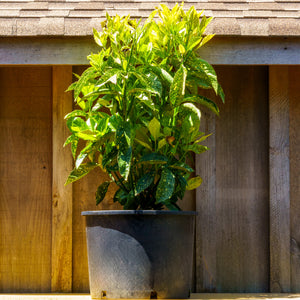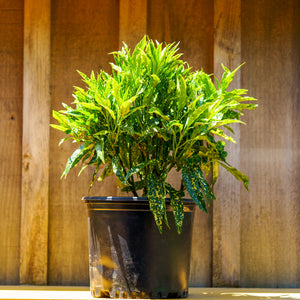The Aucuba Guide
Aucuba, commonly referred to as spotted laurel or gold dust plant, is an evergreen shrub appreciated for its bold, glossy foliage and tolerance for shade. Known for their leathery, variegated leaves often flecked with gold or cream, Aucuba japonica cultivars bring year-round color and texture to the landscape. With their adaptability and low-maintenance nature, aucubas are excellent choices for difficult, shaded garden areas where other plants may struggle.
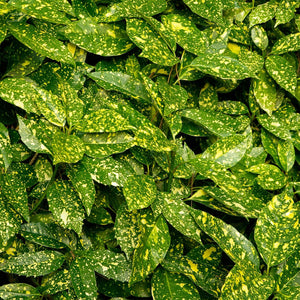
About
Aucuba japonica is native to East Asia and has become a popular ornamental shrub in temperate gardens across North America and Europe. Its thick, leathery leaves are typically dark green, often marked with golden or yellow variegation. Aucuba is dioecious, meaning male and female flowers occur on separate plants. When both are present, female plants may produce glossy red berries in winter that offer additional seasonal interest.
Popular cultivars include Aucuba japonica 'Gold Dust', which features green leaves speckled with bright yellow; Aucuba japonica 'Mr. Goldstrike', known for its more intense golden variegation; and Aucuba japonica 'Emily Rose', which has slightly more compact foliage and a strong upright habit. For fine texture, Aucuba japonica 'Serratifolia' offers deeply toothed margins, while Aucuba japonica 'Hosoba Hoshifu' presents a narrow-leaf form ideal for formal or Asian-inspired landscapes.
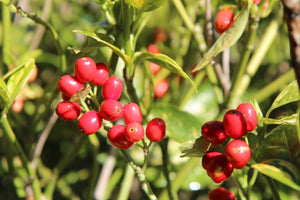
PLANTING
- USDA Hardiness Zones: Most Aucuba cultivars thrive in Zones 6–10, though protection from winter wind is advisable in colder zones.
- Soil: Prefers well-drained, slightly acidic to neutral soil enriched with organic matter. Avoid waterlogged areas, which can lead to root rot.
- Sunlight: Performs best in partial to full shade. Too much direct sunlight may cause leaf scorch, especially on variegated varieties.
- Watering: Water regularly during establishment and in prolonged dry spells. Once established, Aucuba is fairly drought tolerant.
- Spacing: Space plants 3 to 5 feet apart depending on the mature spread of the cultivar.
- Planting Time: Spring or fall planting is ideal to avoid extreme heat or cold. Container-grown plants may be planted at any time with proper care.
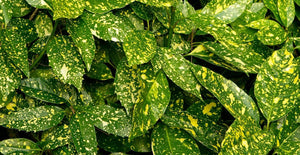
CARE
Aucuba is low-maintenance and responds well to basic care practices that enhance its form and vitality:
- Watering: Deeply water during the first growing season. Once established, supplemental watering is typically only needed in dry weather.
- Fertilizing: Apply a balanced, slow-release fertilizer in early spring to encourage lush foliage. Avoid overfeeding, which may reduce leaf variegation.
- Pruning: Lightly prune in late winter or early spring to maintain shape. Cut back any winter-damaged stems to encourage new growth.
- Mulching: Apply mulch to retain soil moisture and suppress weeds. Keep mulch a few inches away from the crown of the plant to prevent rot.
- Winter Care: In northern climates, protect aucuba from harsh winter winds using burlap wraps or by planting in a sheltered location.
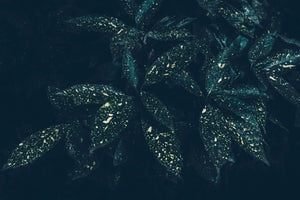
HOW TO USE
Aucuba’s bold foliage and shade tolerance make it a valuable plant in various design applications:
- Foundation Plantings: Use as a backdrop or specimen in shaded beds along buildings.
- Shade Gardens: Combine with hosta, hellebore, ferns, or heuchera for a layered woodland effect.
- Hedges and Screens: Plant in rows to create informal privacy screens or boundary plantings.
- Containers: Aucuba thrives in large containers placed on shaded patios or beneath covered porches.
- Accent Plant: Use bold-leaved cultivars like 'Mr. Goldstrike' or 'Gold Dust' as focal points in part-shade beds.
Aucuba pairs beautifully with broadleaf evergreens like pieris and rhododendron, as well as finely textured plants like Japanese forest grass (Hakonechloa macra) and carex.
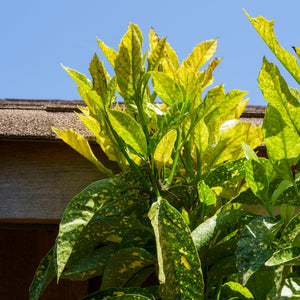
Common Questions
- Are aucuba berries poisonous? Yes, aucuba berries are mildly toxic if ingested and should be kept out of reach of children and pets.
- Are aucuba deer resistant? Aucuba is considered moderately deer resistant due to its leathery leaves, though protection may be necessary in areas with high deer pressure.
- Are aucuba poisonous to dogs? Yes, aucuba contains compounds that may cause mild gastrointestinal upset in dogs if ingested.
- Are aucuba poisonous to cats? Yes, ingestion of aucuba leaves or berries can cause vomiting or drooling in cats.
- How big does aucuba grow? Depending on the cultivar, aucuba typically reaches 4 to 6 feet tall and wide, though some may grow larger under ideal conditions.
- How fast does aucuba grow? Aucuba grows moderately, adding approximately 6 to 12 inches of new growth per year.
- How to care for aucuba? Provide well-drained soil, protect from direct sun, water regularly during dry periods, and prune as needed to shape or remove damage.
- How to grow aucuba from cuttings? Take semi-hardwood cuttings in summer, dip in rooting hormone, and place in a moist, well-drained propagation mix in partial shade until roots develop.
Conclusion
Aucuba is a standout evergreen shrub ideal for brightening shaded areas with its bold foliage and low-maintenance nature. Its adaptability, attractive form, and year-round interest make it a valuable addition to any landscape—whether used in mass plantings, foundation beds, or containers. With its deer resistance and ease of propagation, aucuba offers both beauty and practicality for gardeners looking to enhance shade gardens.
The Aucuba Collection
Sold Out
Sold Out
Sold Out
Sold Out

